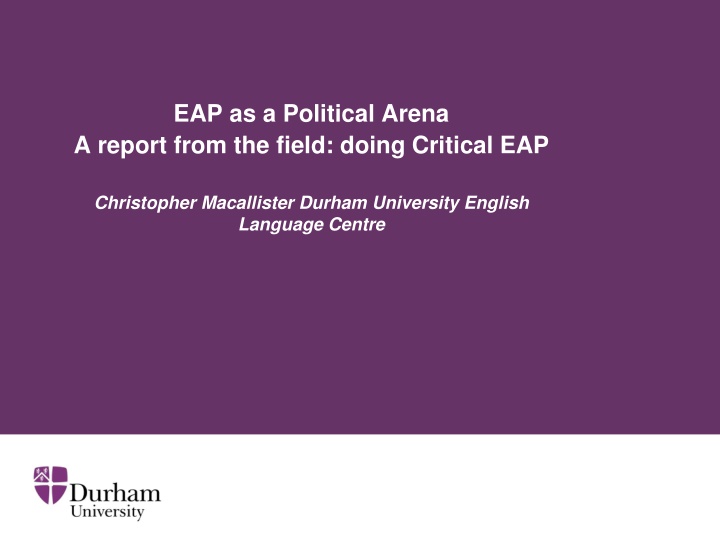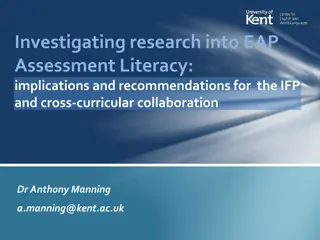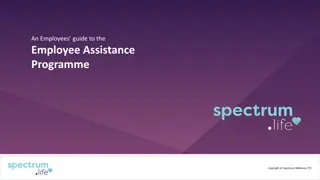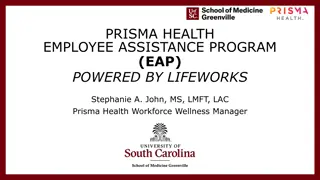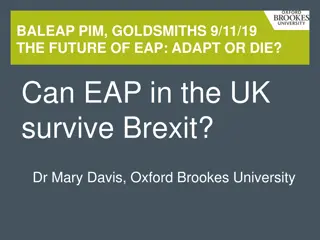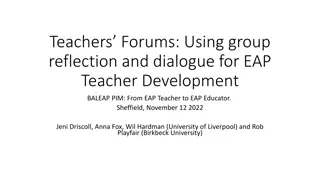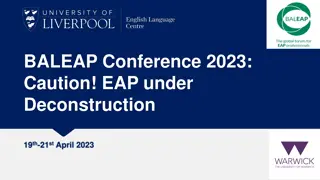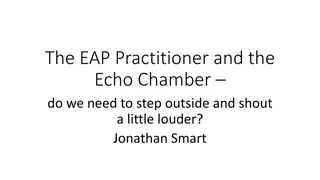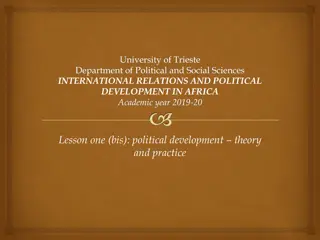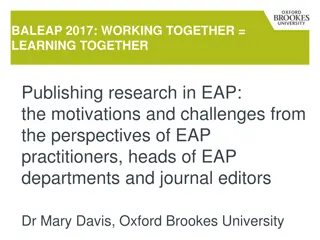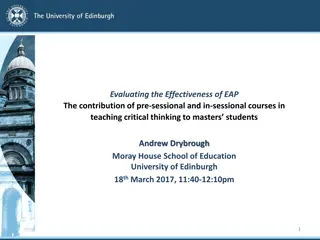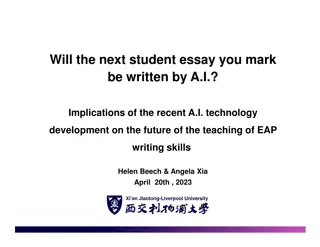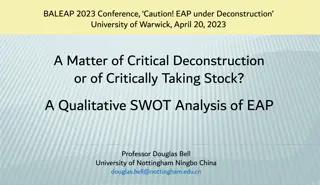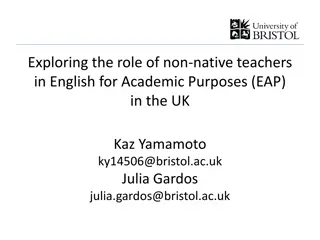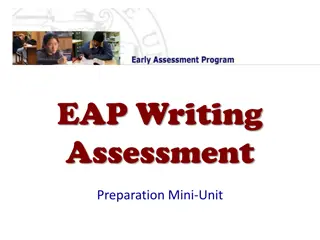Critical EAP: Navigating the Political Arena in English Language Teaching
Explore the realm of Critical EAP (CEAP) through the lens of political theory and pedagogy. Delve into the hazards and dilemmas faced by EAP practitioners as they navigate the balance between teaching for results and engaging in political liberation. Discover three paths to incorporating CEAP in the classroom and learn about a research project examining the implementation of CEAP in EAP classes. Uncover the lesson aims and structure focused on enabling students to see themselves as political actors during their studies in the UK.
Download Presentation

Please find below an Image/Link to download the presentation.
The content on the website is provided AS IS for your information and personal use only. It may not be sold, licensed, or shared on other websites without obtaining consent from the author.If you encounter any issues during the download, it is possible that the publisher has removed the file from their server.
You are allowed to download the files provided on this website for personal or commercial use, subject to the condition that they are used lawfully. All files are the property of their respective owners.
The content on the website is provided AS IS for your information and personal use only. It may not be sold, licensed, or shared on other websites without obtaining consent from the author.
E N D
Presentation Transcript
EAP as a Political Arena A report from the field: doing Critical EAP Christopher Macallister Durham University English Language Centre
What is Critical EAP (CEAP)? Critical Theory Critical Pedagogy Critical EAP The EAP classroom is political: 1990s - Benesch & Pennycook The EAP classroom is an opportunity of political and social change CEAP is debated (a lot) and done classrooms (a little)
The Hazards & the Dilemma of CEAP What gives EAP practitioners the right to liberate anyone? Do students need/want liberating? The opportunity cost of doing CEAP The critical dilemma: does the politically aware EAP practitioner simply forget about politics and teach for results. Or can you do CEAP without imposing yet another hegemonic discourse?
Three paths to CEAP in the classroom: 1. The political/social/economic controversial topic 2. A Critical needs analysis: ask not how you can shape students to university, rather how can you shape the university to the students 3. Undertaking real political action
The research project 2 PG EAP classes 1 drawn from across Durham in-sessional students: class advertised as academic skills CEAP covert 1 drawn from MA TESOL students: CEAP overt badged as an experimental class Data: focus groups with the classes Interviews with the teachers and a teacher observer
The lesson: aims... Critical aims: to enable the students to see themselves as political actors during their studies in the UK with: Responsibilities Rights Expressed through doing political action EAP aims - opportunities to practice: Seminar skills Email writing
The lesson: structure... Part 1. awareness raising tasks: Political participation in the UK Chains of delegation and accountability Where do international students fit in rights and responsibilities Part 2. Political action Setting the scene PMQs listening Writing a question for Jeremy Corbyn to ask Teresa May Sending the question by email
What happened: the students stories i. The lesson was interesting we learnt more about the UK, its culture and our role There wasn t enough language or skills I enjoyed it, but why did we do it? iii. I wanted to learn how to write an email iv. Why don t we do this on pre-sessional v. I m walking out after 5 minutes vi. Could we do more on our legal right and human rights vii. A reading before the class, you did this on pre-sessional, would have made it more challenging and we could have got more from the lesson ii.
The students on empowerment & indoctrination i. We are powerful I m Chinese! ii. Yes the teacher has a strong voice but I m an international postgraduate I have my own mind iii. Its uncomfortable and embarrassing if the teachers goes on and on telling us about their political views... I cringe
What happened 2: the teachers tales i. I enjoyed it, it was challenging but doable ii. I liked the way the materials were about their political context... It wasn t about teaching an ideology iii. I was surprised how well the students took to it. Their home countries politics didn t seem to matter iv. I felt I was teaching a subject...civics or citizenship... Was it an EAP class?
Stories from the teacher/observer, & a manager/teacher i. Its interesting but I m not sure I would have put in a timetable ii. There s P, but not enough E & A iii. Where s the language? I think the classroom should be focused on the language, they didn t learn anything iv. It humanised the students...I saw them differently
The researchers view: i. Critical aims were achieved ii. The students engaged with political concepts and situated themselves as political actors iii. They engaged in a political act in class iv. The academic language tasks weren t challenging enough v. Both teachers delivered the political theory element successfully
CEAP: a response to the hazards and the critical dilemma i. You can avoid the dilemma facilitate don t preach ii. Add more E and A with sufficiently challenging materials there will be E and A to engage with iii. Or accept using a session (or several?) to be political
A Union of Results & Politics EAP is results orientated the most high stakes form of ELT EAP is political Engaging with the political offers real gains: Students can become more engaged with the structures they live in a more critical student Awareness of rights and political role results in HE institutions that are more responsive to their international students We the EAP practitioner see our students in a more holistic light
